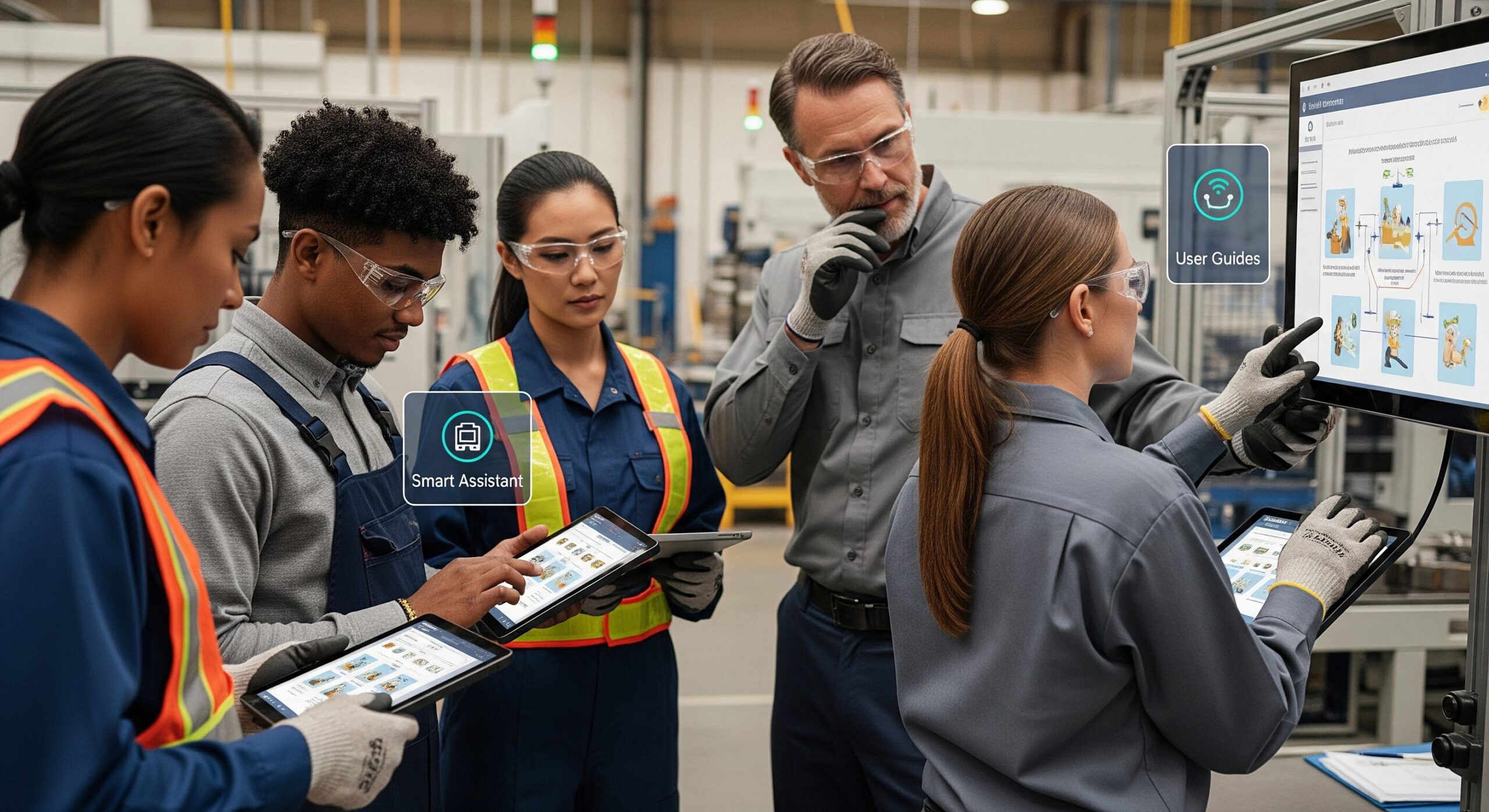Building Innovative Smart Spaces: Leveraging AI for Collaboration and Productivity

Why Workflow Friction Is Still Undermining Team Performance
Despite years of digital transformation, many teams are still slowed by the basics. Manual tasks that consume valuable time, knowledge that remains siloed, and navigating disconnected systems that continue to disrupt flow and collaboration.
Even with dozens of platforms in place, teams struggle to work with consistency and clarity. Documents live in too many places. Critical expertise stays locked in individual heads. And aligning across functions often means switching tools, retracing steps, and filling in gaps.
The issue isn’t lack of technology; it’s lack of integration. Context gets lost, workflows fragment, and quality becomes harder to sustain.
Leaders feel the strain. They see what their teams are capable of, and how much time is lost to friction. But most solutions feel too narrow, too rigid, or too resource-intensive to scale.
That’s where practical AI applications like AI Smart Spaces come in. These intelligent environments don’t replace your existing systems but connect and enhance them. They automate repetitive tasks, surface institutional knowledge, and support faster, more consistent output, without increasing overhead or complexity.
They don’t just make work faster. They make it more focused, more scalable, and more human.
What Are AI Smart Spaces?
Even in organizations with advanced tools, essential work still gets held up, by formatting, version control, or the simple task of finding the right content. AI Smart Spaces address these bottlenecks by organizing how teams work with information. They reduce friction in daily operations by automating repetitive tasks, structuring workflows, and preserving institutional knowledge.
At Viable Synergy, we design Smart Spaces not as standalone tools, but as intelligent systems that integrate with the way teams already work. They’re not dashboards or chat apps. They’re structured environments that help teams generate consistent, high-quality outputs, without starting from scratch every time.
The purpose is simple: free up capacity for the work that requires judgment, creativity, and collaboration.
Here’s what Smart Spaces do:
- Streamline workflows by reducing repetitive tasks like formatting, document assembly, and approval routing
- Ensure consistency in branding, legal language, and compliance across all deliverables
- Break down silos with natural language search that lets teams find and reuse content fast
- Simplify complex documents like Master Services Agreements (MSAs), Statements of Work (SOWs), and Requests for Proposals (RFPs)
- Enable scalable, repeatable processes that grow with your business—without compromising quality
In practice, Smart Spaces help teams:
- Generate client-ready proposals that reflect brand and compliance standards
- Maintain a consistent voice across regions and departments
- Reuse the best content without losing time searching for it
- Automatically update templates and documents when policies or pricing change
These are practical AI applications built to work consistently for your needs and your people.
The Business Problems AI Smart Spaces Solve
AI Smart Spaces are designed to address a familiar set of challenges that slow teams down, not because of lack of effort, but because of how work is structured.
Time-Consuming Manual Workflows
Teams still spend hours formatting documents, updating templates, or tracking down the latest version of a file.
These tasks aren’t strategic, but they’re unavoidable. As a result, high-value employees spend significant time on repetitive work that adds limited business value, and project timelines quietly slip.
Leaders often recognize that productivity is lower than expected—but they lack clear visibility into where time is being lost or why deliverables are taking longer than planned.
Across industries, this shows up in different ways:
- Missed deadlines on grant proposals and RFPs in healthcare
- Lag time in production documentation in manufacturing
- Delays in client delivery in professional services
Siloed Institutional Knowledge
Critical knowledge often lives in individual inboxes, scattered folders, or someone’s head.
When that person is unavailable—or leaves—teams face delays, confusion, or rework. Leaders are left managing continuity risks that shouldn’t depend on a single person.
- In manufacturing, inconsistent onboarding slows down new hires.
- In healthcare, it takes too long to find past submissions or protocols.
- In professional services, entire reports are recreated simply because the last one can’t be found.
Inconsistent and Unscalable Outputs
Even routine documents, like Master Services Agreements, Statements of Work, or client deliverables, are often recreated from scratch or reused inconsistently. Brand tone drifts. Compliance phrasing gets modified. Formatting varies.
What should be standard becomes variable—and that makes scale feel like a risk, not an advantage. This shows up as reputational risk, lost time in reviews, and rising rework across teams.
These aren’t isolated issues. They reflect systemic friction, the kind that slowly compounds and holds back even the most capable teams.
AI Smart Spaces solve these problems not by adding more tools, but by reducing friction where it happens, structuring information so it can be reused, and enabling repeatable, high-quality outputs without constant oversight.
How AI Smart Spaces Elevate Collaboration and Productivity
When AI Smart Spaces are in place, the way teams work starts to shift, in ways that feel natural, not disruptive.
Instead of duplicating effort, teams build on reusable, high-quality assets. Proposals, templates, and playbooks are no longer reinvented; they’re refined. Subject matter expertise isn’t trapped in someone’s inbox or memory. It’s searchable, structured, and accessible across teams and time zones.
Cross-functional work gets easier. Smart Spaces bring structure to workflows, guiding teams with embedded logic, preformatted documents, and automated updates that reduce manual effort across every stage of the process.
Here’s how they deliver impact:
Enable scalable, repeatable processes
Teams can generate client-ready proposals, reports, and deliverables without starting from scratch. Structured content, brand-aligned templates, and standardized inputs mean consistency without added effort.
Reduce friction across handoffs and reviews
With version control, embedded review logic, and automated formatting, teams spend less time chasing updates and more time moving work forward. Everyone works from a shared, current foundation.
Preserve knowledge while reducing dependency on individuals
Smart Spaces capture expert insight in a durable format, ready to support onboarding, AI upskilling, corporate AI training, and continuity across role transitions or team changes.
Support multilingual, multi-team collaboration
With built-in localization and accessibility tools, global teams can engage consistently—whether they’re collaborating across languages or adapting documents for regional compliance.
At every level, Smart Spaces are designed to enable people to do their best work. That means less time formatting, cross-checking, or tracking down information, and more time focused on strategy, creativity, and results.
Each Smart Space is made up of modular components tailored to how your teams work. From AI-powered templates and knowledge repositories to embedded review flows and approval logic, every part is designed to scale. Not just across one department, but across teams, locations, and use cases.
From People to Platforms—Why This Works for Visionary Leaders
For many business leaders, scaling isn’t just about increasing output; it’s about preserving what works, protecting institutional knowledge, and ensuring teams can grow without losing clarity or quality.
AI Smart Spaces help make that possible.
They reduce reliance on key individuals by turning high-quality work into durable, repeatable systems. Best practices, brand voice, and subject matter insights aren’t trapped in inboxes; they’re built into how work flows. That foundation also supports onboarding and corporate AI training, helping teams adopt new workflows faster without losing momentum.
The result? Teams that are more consistent, capable, and scalable, without adding headcount or complexity.
But the value goes deeper than productivity. For visionary leaders, it’s about continuity—protecting what they’ve built, equipping their teams for long-term success, and navigating transformation without compromising their identity or values.
Leaders still set the vision, drive change, and carry responsibility. Smart Spaces simply remove the structural friction that gets in the way.
And because every Smart Space is tailored, and not off-the-shelf, they respect each organization’s standards, voice, and way of working. They scale what already works, and create space for people to go further, with more clarity and less rework.
Bringing It to Life: What an AI Smart Space Might Include
No two Smart Spaces are exactly alike. Each is designed around the way a specific organization works: its content, workflows, brand standards, and goals. But most include a core set of intelligent components that work together to reduce friction and enable high-quality, repeatable work at scale.
Here’s what an AI Smart Space might include:
Smart document generation: Automatically drafts proposals, templates, and recurring reports using pre-approved language, structured inputs, and reusable assets, saving time without sacrificing quality.
Version automation: When policies, prices, or templates change, updates are reflected automatically across all relevant documents, minimizing rework and ensuring consistency.
Embedded brand and compliance standards: Formatting, tone, and regulatory language are built into every deliverable. Teams are guided by built-in prompts and tooltips to follow process and quality standards, without requiring constant oversight.
Context-aware guidance: Employees get smarter, just-in-time support as they create or complete documents. Prompts adjust based on role, document type, or client context, so work gets done right the first time.
Natural language search and reuse: Makes it easy to find, adapt, and repurpose past work. Instead of recreating content from scratch, teams can build on what is already working.
Multilingual support: Enables global teams to access workflows, templates, and content in their preferred languages, supporting cross-border consistency and communication.
Integration with current tools: Smart Spaces don’t require switching platforms. They integrate with tools like SharePoint, Google Workspace, Salesforce, or other existing systems, streamlining work instead of disrupting it.
Integration with internal data and historical content: Viable Synergy’s team of experts works closely with each organization to identify and structure the most relevant data sources, legacy documents, and proven materials. This ensures each Smart Space is built on trusted, foundational content that reflects how the business actually operates, and evolves.
Smart Spaces also play a critical role in AI upskilling by embedding guidance, best practices, and institutional knowledge directly into the workflows employees use every day.
Each implementation is tailored and configured to the organization’s workflows, content formats, and strategic priorities. The value doesn’t lie in any one feature. It’s in how they come together to solve the right problems in the right way.
Each Smart Space brings together practical AI applications that support everyday execution; not as experiments, but as systems teams actually use.
In practice, that might mean:
- Preparing branded, compliant RFP responses in minutes, not days
- Standardizing onboarding materials so every new hire starts strong
- Automating version updates across hundreds of recurring reports
- Giving teams access to the best examples, answers, and templates, without having to ask around
It’s not about adding more tools. It’s about turning what already works into something that’s structured, scalable, and built to last.
Every Scalable System Starts with Solving the Right Problem
Scalable systems don’t emerge by accident. They’re built intentionally, starting with the real points of friction that hold teams back.
When leaders focus on solving specific challenges like manual workflows, siloed knowledge, or inconsistent deliverables, they lay the foundation for something far more powerful: a system that scales with them.
Viable Synergy’s AI Smart Spaces are built with this philosophy in mind. They’re not abstract “transformation” initiatives. They’re practical systems that reflect how work actually gets done and how it can work better.
That’s what makes them scalable. They align to real tasks, remove structural drag, and create consistency across teams, timelines, and tools.
In many organizations, Smart Spaces don’t just improve execution. They become the starting point for broader operational maturity and responsible, future-ready AI integration.
They create space for people to lead, collaborate, and innovate, with less overhead and more confidence.
Ready to explore what Smart Spaces could look like for your team?
Let’s identify the right starting point—one that solves a real problem and sets the stage for lasting business success.
Schedule an AI Strategy Session Today
Frequently Asked Questions (FAQs)
AI Smart Spaces are integrated work environments that connect your existing tools, surface institutional knowledge, and guide teams to produce consistent, high‑quality outputs, without starting from scratch.
A Smart Space is an AI-powered work environment that connects tools, automates workflows, and preserves knowledge. For example, it can generate client-ready proposals in professional services, assemble grant responses in healthcare, or create accurate production docs in manufacturing, scaling what already works while reducing friction.
They’re structured systems with embedded logic, templates, approvals, and version automation. The goal is repeatable, compliant delivery, not ad‑hoc answers or static reporting.


